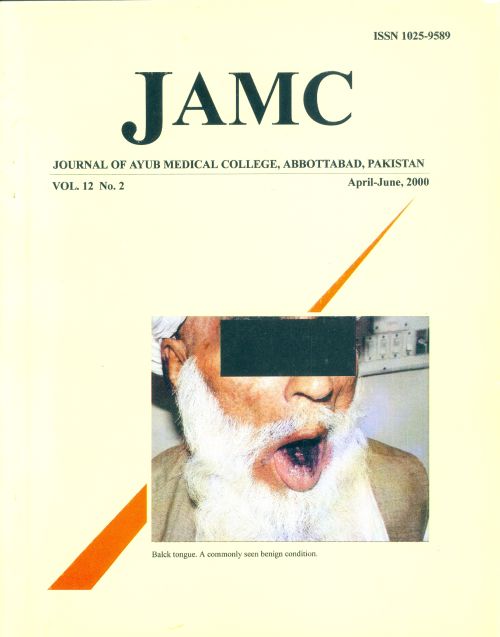A STUDY OF SERUM LIPID PATTERN IN THALASSAEMIC PATIENTS
Abstract
Background: Thalassaemia is among the most common genetic diseases of man and the commonest inherited disorderin our country. This study was carried out to assess the lipid pattern in thalassaemic patients and to find out any
significant variation in lipid pattern of these patients. Methods: Eighty thalassaemic patients (Group A) were selected
from various blood transfusion centers and hospitals. Fifty, age and sex matched, normal controls (Group B) were also
included in the study. 3.0 ml blood was drawn aseptically from the antecubital vein of each subject. The serum was
separated and stored at 4°C till analysed. Serum total cholesterol (TC) and triglycerides (TG) of all the subjects were
estimated using the commercially available kits. Results: There was a statistically significant difference (P<0.05) in
the serum TC concentrations of thalassaemic patients as compared to those of normal controls. Scrum TG levels of
thalassaemic patients were raised as compared to those of normal controls (though not statistically significant).
Conclusion: There is a need to design a larger study to evaluate the real status of lipids and lipoprotein subtractions in
thalassaemic patients.
References
Nienhuis AW. Anagnou XP, Ley TJ. Advances in
thalassemia research. Blood 19X4; 63(4): 73X-
X.
Saleem M. Ahmed S. Khattak MF. An overview
of thalassaemia in Pakistan. 4U| International
Conference. Peshawar: Pakistan Association of
Pathologists. 1996: 76.
Alter BP. Prenatal diagnosis of
haemoglobinpathies and other hematologic
diseases. J Pediatr 1979; 95(4): 501-1.3.
Saleem M. Thalassaemia in Pakistan. In: One Day
Symposium on Thalassaemia in Pakistan. Lahore:
Pakistan Thalassaemia Welfare Society. 1991: 1-
JAMC, Vol. 12, No. 2, 2000
Tassiopoulos T, Stamatelos G. Zakopoulos N.
Fessas P. Eliopoulos GD. Lou incidence of acute
myocardial infarction in beta-thalassaemia trait
carriers. Haematological Budap 1995: 26(4): 199-
kaminska M. Badzio T. ksiezopolskakaczorowska. A Bako W. Boj E. Przymanowski
Z. High-molecular weight lipoprotein
concentrations in pneumonia in children and
experimental animals. Probl Med Wieku Rozwoj
: 12: 363-75.
Harbige S. Nutrition and immunity with emphasis
on infection and autoimmune disease. Nutr Health
: 10(4); 2X5-312.
X. Griffith JF, king AD. Chan YL. Clinics in
diagnostic imaging. Singapore Med J 1997. 38(9):
-404.
Livrea MA, Tesoriere L. Pintaudi AM. et al.
Oxidative stress and antioxidant status in (5-
thalassemia major: Iron overload and depletion of
lipid-soluble antioxidants. Blood 1996: 88(9):
-3614.
Giardini O. Murgia F. Martino E. Mannarino O.
Corrado G, Maggioni G. Serum lipid pattern in
beta-thalassemia Acta Haematol 1978:60(2): 100-
Maioli M. Pettinato S. Cherchi GM. et al. Plasma
lipids in Beta- thalassaemia minor.
Atherosclerosis 1989; 75(2-3): 245-48.
Scutellari PX. Orzincolo C. Franceschini F. Bagni
B. The radiographic appearances following
adequate transfusion in beta-thalassaemia.
Skeletal Radiol 19X9: 17:545-50.
Cazzola M. Pootrakul P. Bergamaschi G. Helpers
HA. Eng M. Finch CA. Adequacy of iron supply
for eiythropropoiesis: in vivo observations in
humans. .1 Lab Clin Med 19X7: 110: 734- 39.
Windier E, Ewers-Grabow L. Thiery .1, Walli A
Seidel D. Greten II. The prognostic value of
hypocholesterolemia in hospitalized patients. Clin
Investing 1994, 72(12): 939-43.
Verdery RB. Goldberg AP. Hypocholesterolemia
as a predictor of death: A prospective study of 224
nursing home residents. J Gerontol 1991:46(3):
MX4-90.
Walter JB, Talbot 1C. Gardner HA et al. Genial
Pathology. 7'1' Ed. London: Churchill
Livingstone, 1996: 806-810.
Ganong WF. Review of Medical Physiology. X
Ed. Stamford: Appleton and Lange. 1997: 815-40
How to Cite
Issue
Section
License
Journal of Ayub Medical College, Abbottabad is an OPEN ACCESS JOURNAL which means that all content is FREELY available without charge to all users whether registered with the journal or not. The work published by J Ayub Med Coll Abbottabad is licensed and distributed under the creative commons License CC BY ND Attribution-NoDerivs. Material printed in this journal is OPEN to access, and are FREE for use in academic and research work with proper citation. J Ayub Med Coll Abbottabad accepts only original material for publication with the understanding that except for abstracts, no part of the data has been published or will be submitted for publication elsewhere before appearing in J Ayub Med Coll Abbottabad. The Editorial Board of J Ayub Med Coll Abbottabad makes every effort to ensure the accuracy and authenticity of material printed in J Ayub Med Coll Abbottabad. However, conclusions and statements expressed are views of the authors and do not reflect the opinion/policy of J Ayub Med Coll Abbottabad or the Editorial Board.
USERS are allowed to read, download, copy, distribute, print, search, or link to the full texts of the articles, or use them for any other lawful purpose, without asking prior permission from the publisher or the author. This is in accordance with the BOAI definition of open access.
AUTHORS retain the rights of free downloading/unlimited e-print of full text and sharing/disseminating the article without any restriction, by any means including twitter, scholarly collaboration networks such as ResearchGate, Academia.eu, and social media sites such as Twitter, LinkedIn, Google Scholar and any other professional or academic networking site.









